Further Result on Finite-Time Stabilization of Stochastic Nonholonomic Systems
Abstract
This paper further investigates the problem of finite-time state feedback stabilization for a class of stochastic nonholonomic systems in chained form. Compared with the existing literature, the stochastic nonholonomic systems under investigation have more uncertainties, such as the x0-subsystem contains stochastic disturbance. This renders the existing finite-time control methods highly difficult to the control problem of the systems or even inapplicable. In this paper, by extending adding a power integrator design method to a stochastic system and by skillfully constructing C2 Lyapunov function, a novel switching control strategy is proposed, which renders that the states of closed-loop system are almost surely regulated to zero in a finite time. A simulation example is provided to demonstrate the effectiveness of the theoretical results.
1. Introduction
The nonholonomic systems, which can be used to model many frequently met mechanical systems, such as wheeled mobile robot, knife edge and rolling disk, have been an active research field over the past decades. From Brockett’s necessary condition [1], it is well known that the nonholonomic systems cannot be stabilized to the origin by any static continuous state feedback, so the classical smooth control theory cannot be applied directly. In order to overcome this obstruction, several novel approaches have been developed for the problem, such as discontinuous time-invariant stabilization [2, 3], smooth time-varying stabilization [4–6], and hybrid stabilization [7]. Using these valid approaches, many fruitful results have been developed [8–15]. Particularly, the stochastic nonholonomic systems, which can be viewed as the extension of the classical nonholonomic systems, have been recently achieved investigations [16–18]. However, it should be noted that those aforementioned papers consider the feedback stabilizer that makes the trajectories of the systems converge to the equilibrium as the time goes to infinity.
Compared to asymptotic stabilization, the closed-loop system with finite-time convergence usually demonstrates faster convergence rates, higher accuracies, better disturbance rejection properties, and robustness against uncertainties [19]. Hence, it is more meaningful to investigate the finite-time stabilization problem than the classical asymptotical stability. For the deterministic case, in [20], a novel switching finite-time control strategy was proposed to nonholonomic systems in a chained form with uncertain parameters and perturbed terms by the use of time rescaling and Lyapunov based method. Later this result was essentially extended under weaker constraints on drift terms in [21]. As a natural extension, the finite-time stabilization for stochastic nonholonomic systems is an interesting and challenging subject of intensive study. However, it cannot be solved by simply extending the methods for deterministic systems because of the presence of stochastic disturbance. As pointed out by Yin et al. [22], “the existence of a unique solution and the non-satisfaction of local Lipschitz condition are two prerequisites of discussing the finite-time stability for a stochastic nonlinear system. That is, as a common assumption condition to guarantee the existence of a unique solution for stochastic nonlinear system, local Lipschitz condition cannot be applied to study stochastic finite-time stability.” Therefore, the finite-time controller design for stochastic nonholonomic systems should solve the following questions: under what conditions, the stochastic nonholonomic systems exist possibly finite-time stabilizer? Under these conditions, how can one design a finite-time state feedback stabilizing controller?
To the best of the authors’ knowledge, only the authors in [23] considered the aforementioned problems when the x0-subsystem is ordinary differential equation. This paper continues the investigation in [23] and addresses the finite-time stabilizing control design for stochastic nonholonomic systems with more uncertainties than those in [16–18, 23], which cannot be handled by general existing methods. A constructive method in designing finite-time stabilizing controller for such uncertain system is proposed. The contribution of this paper is highlighted as follows. First, inspired by the deterministic works in [24, 25], we generalize adding a power integrator design method [26] to a stochastic system, and a novel C2 Lyapunov function is constructed to deal with stochastic disturbances. Second, based on a new switching method, a systematic control design procedure is proposed to solve the finite-time stabilization problem for all plants in the considered class.
The remainder of this paper is organized as follows. Section 2 presents some necessary notations, definitions, and preliminary results. Section 3 describes the systems to be studied and formulates the control problem. Section 4 presents the design scheme to the controller and the main result. Section 5 gives a simulation example to illustrate the theoretical finding of this paper. Finally, concluding remarks are proposed in Section 6.
2. Notations and Preliminary Results
The following notations, definitions, and lemmas are to be used throughout the paper. R+ denotes the set of all nonnegative real numbers, and Rn denotes the real n-dimensional space. (a, b) odd denotes the set {x∣x = p/q and x ∈ (a, b), where p and q are odd integers}. (a, b) even denotes the set {x∣x = p/q and x ∈ (a, b), where p is an even integer and q is an odd integer}. For a given vector or matrix X, XT denotes its transpose, Tr {X} denotes its trace when X is square, and |X| is the Euclidean norm of a vector X. Ci denotes the set of all functions with continuous ith partial derivatives. K denotes the set of all functions: R+ → R+, which are continuous, strictly increasing, and vanishing at zero; K∞ denotes the set of all functions which are of class K and unbounded. The arguments of the functions (or the functionals) will be omitted or simplified, whenever no confusion can arise from the context. For instance, we sometimes denote a function f(x(t)) by simply f(x) or f.
We begin with some basic concepts and terminologies related to the notion of stochastic finite-time stability. The reader is referred to [22, 27, 28] as well as the references therein for additional details.
Definition 1. For system (1), define T0(x0, w) = inf {T ≥ 0 : x(t, x0) = 0, for all t ≥ T}, which is called the stochastic settling time function. Especially, T0(x0, w): = +∞ if x(t, x0) ≠ 0, for all t ≥ 0.
Definition 2. The equilibrium x ≡ 0 of the system (1) is said to be a stochastic finite-time stable equilibrium if
- (i)
it is stable in probability: for every pair of ε ∈ (0,1) and r > 0, there exists δ > 0 such that P{|x(t, x0)| < r, for all t ≥ 0} ≥ 1 − ε, whenever | x | < δ;
- (ii)
its stochastic settling-time function T0(x0, w) exists finitely with probability and E[T0(x0, w)] < ∞.
Next, we give two lemmas where the first one provides sufficient conditions to ensure the existence of pathwise unique strong solution to system (1), and the other one has been used to determine the finite-time stability of stochastic nonlinear systems.
Lemma 3 (see [23], [29].)Assume that f(t, x) and g(t, x) are continuous in x. Further, for any 0 < δ < 1, each N = 1,2, …, and each 0 ≤ T < ∞, if the following conditions hold:
Lemma 4 (see [30].)Consider the stochastic nonlinear system described in (1). Suppose that there exist a C2 function V(x), class K∞ functions μ1 and μ2, real numbers c > 0 and 0 < α < 1, such that
Then we list two lemmas that serve as the basis of the key tools for the adding a power integrator technique.
Lemma 5 (see [31].)For x ∈ R, y ∈ R, and p ≥ 1 being a constant, the following inequalities hold:
Lemma 6 (see [32].)Let x, y be real variables; then for any positive real numbers a, m, and n, one has
3. Problem Formulation
Remark 7. Obviously, the stochastic nonholonomic system (8) contains more uncertainties in drift and diffusion terms than those in the closely related papers [16–18, 23]. This, especially the existence of stochastic disturbance in the x0-subsystem, renders the procedure of control design in [23] inapplicable to the finite-time control problem of the system. Up to now, how to design a stabilizing controller to achieve the finite-time stabilization of the system (8) is unsolved. It is precisely our intention of this paper.
The following assumptions regarding system (8) are imposed throughout the paper.
Assumption 8. For i = 0, …, n, there are known positive constants ci1 and ci2 such that
Assumption 9. For f0 and g0, there are constants a > 0 and r ∈ (0,1) odd such that
Assumption 10. For i = 1, …, n, there is a constant b > 0 such that for any τ ∈ (−2/(4n + 1), 0),
For simplicity, in this paper we assume that τ = −p/q with p being any even integer and q being any odd integer, under which and the definition of mi in Assumption 10, we know that mi is an odd number.
Remark 11. Noting that f0(t, 0) = 0, g0(t, 0) = 0, fi(t, x0, 0) = 0 and gi(t, x0, 0) = 0 are assumed, Assumptions 9 and 10 imply that
4. Finite-Time Control Design
In this section, we give a constructive procedure for the finite-time stabilizer of system (8). The design of finite-time state feedback controller is divided into two steps.
Step A. We first stabilize the x-subsystem in a finite time almost surely.
Based on Lemmas 5 and 6, the following proposition is given to estimate the last seven terms on the right-hand side of (25).
Proposition 12. There exists a positive constant lk such that
Proof. The similar proof can be found in [23] and thus it is omitted here.
Substituting (26) into (25), we obtain
Clearly, the C0 virtual controller
So the following result is obtained.
Lemma 13. If Assumptions 8 and 10 hold for the stochastic nonlinear system (15), then the solution of the closed-loop system consisting of (15) and (30) is finite-time stable in probability.
Proof. From (23) and (30), it is not hard to verify that all conditions in Lemma 3 are satisfied, which means that the closed-loop system admits a unique solution. Next we prove that the closed-loop system is globally finite-time stable in probability.
First of all, by using Lemma 5, it is easy to see that
So we have the following estimate
Let α = 4lσ/(4lσ − τ). With (33) and (31) in mind, by Lemma 5, it is not difficult to obtain that
Therefore, by Lemma 4, the uncertain system (15) with the controller (30) is globally finite-time stable in probability and its stochastic settling time T1(x(0), w) satisfies
Step B. Then we design a state feedback controller such that the x0-subsystem is finite-time stable in probability.
Up to now, we have finished the finite-time stabilizing controller design of the system (8). Consequently, the following theorem can be obtained to summarize the main result of the paper.
Theorem 14. Under Assumptions 8–10, if the proposed control design procedure together with the previous switching control strategy is applied to system (8), then, for any initial conditions in the state space (x0, x) ∈ Rn+1, the closed-loop system is globally finite time regulated at origin in probability.
Remark 15. The settling time of the closed-loop system depends on design parameters k0, M and initial conditions, that is, when the initial conditions are known, the settling-time can be arbitrarily adjusted by the choice of appropriate design parameters k0 and M.
5. Simulation Example
We choose τ = −2/11, which together with m1 = 1 implies that m2 = 9/11. By Lemma 5, it is verified that Assumptions 9-10 are satisfied with a = b = 1/2. Assumption 8 holds with 1 ≤ 1.5 + 0.5cos t ≤ 2; hence the controller proposed in this paper is applicable.
When (x0(0), x1(0), x2(0)) = (1, −1,1), by choosing σ = 3 and l = 2/3, according to the design procedure proposed in Section 4, a state feedback stabilizing controller can be explicitly given. Using MATLAB, Figures 1 and 2 are obtained to exhibit the trajectories of the closed-loop system. From these figures, we can see that the states of the closed-loop system are finite time regulated to zero almost surely.
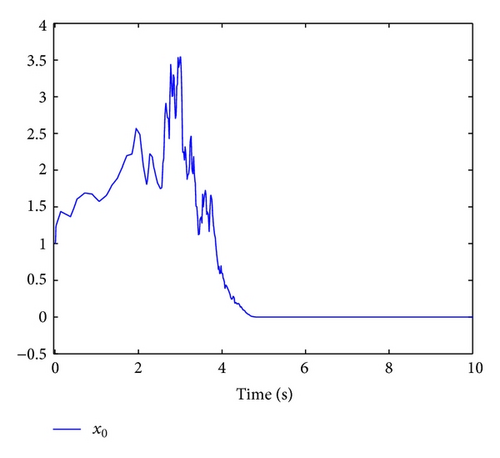
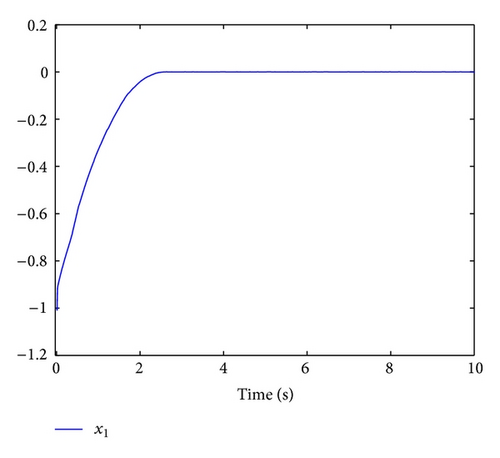
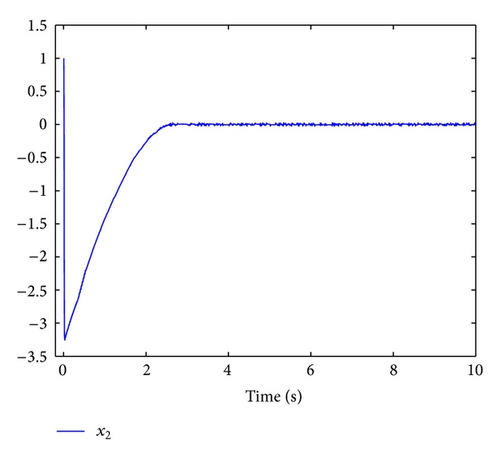
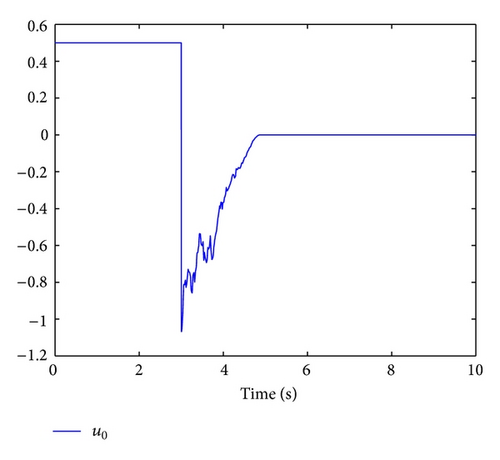
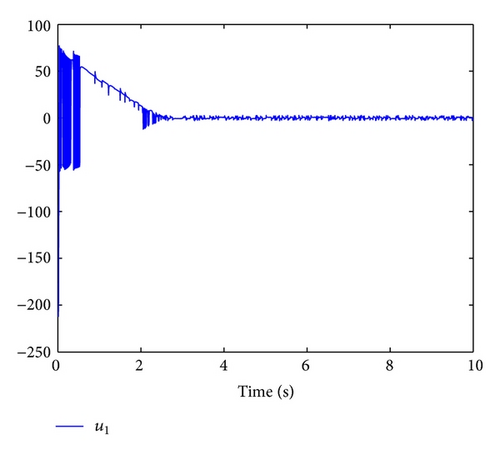
6. Conclusion
In this paper, the finite-time state feedback stabilization problem has been investigated for a class of nonholonomic systems with more general stochastic disturbances. With the help of adding a power integrator technique, a systematic control design procedure is developed in the stochastic setting. It should be noted that the proposed controller can only work well when the whole state vector is measurable. Therefore, a natural and more interesting problem is how to design output feedback stabilizing controller for the system studied in the paper if only partial state vector is measurable, which is now under our further investigation.
Acknowledgments
This work has been supported in part by National Nature Science Foundation of China under Grants 61073065 and 61273091 and the Key Program of Science Technology Research of Education Department of Henan Province under Grant 13A120016. The authors thank the editor and the anonymous reviewers for their constructive comments and suggestions for improving the quality of the paper.




